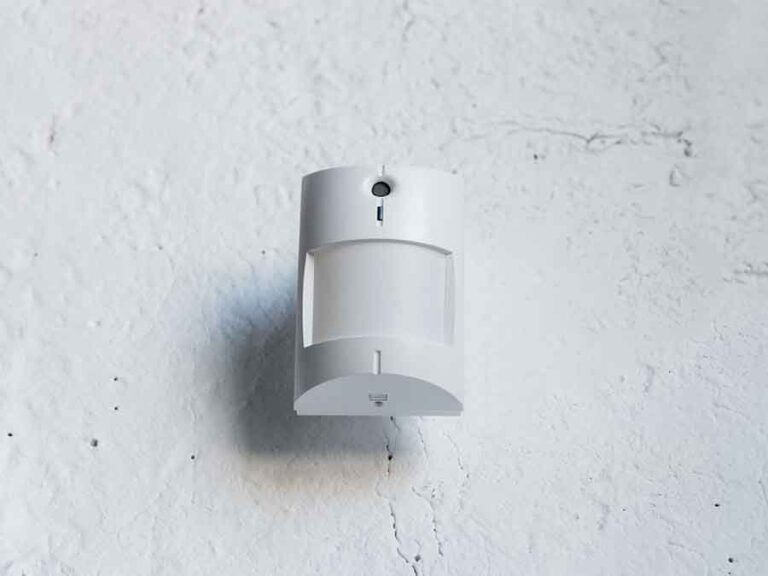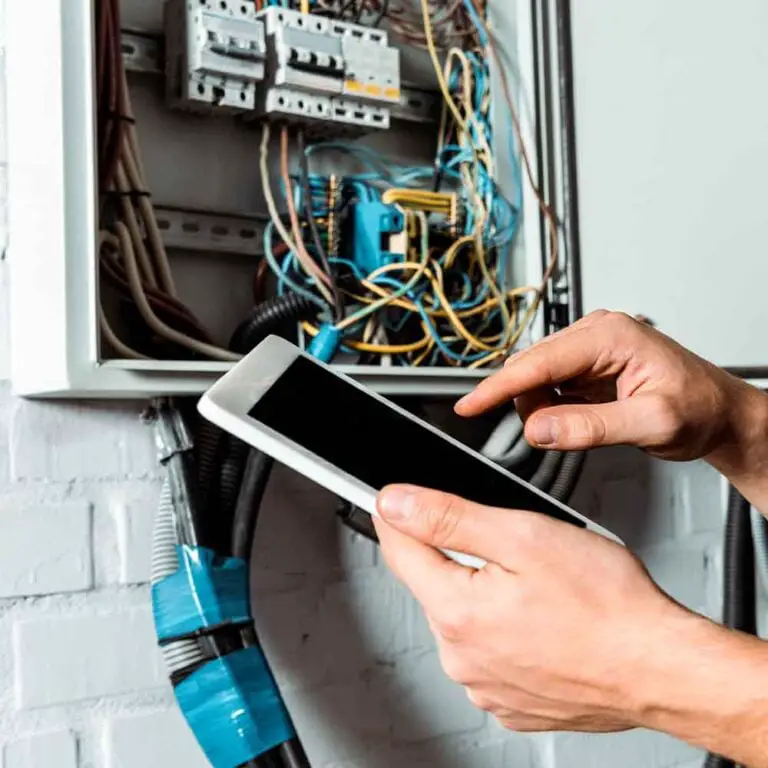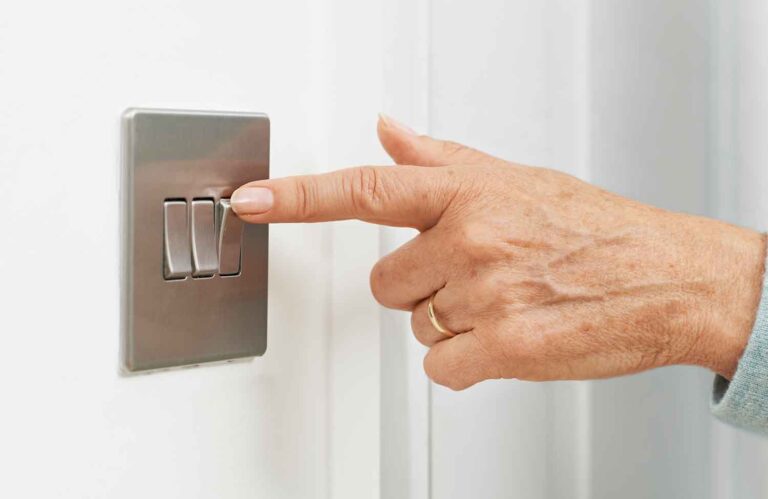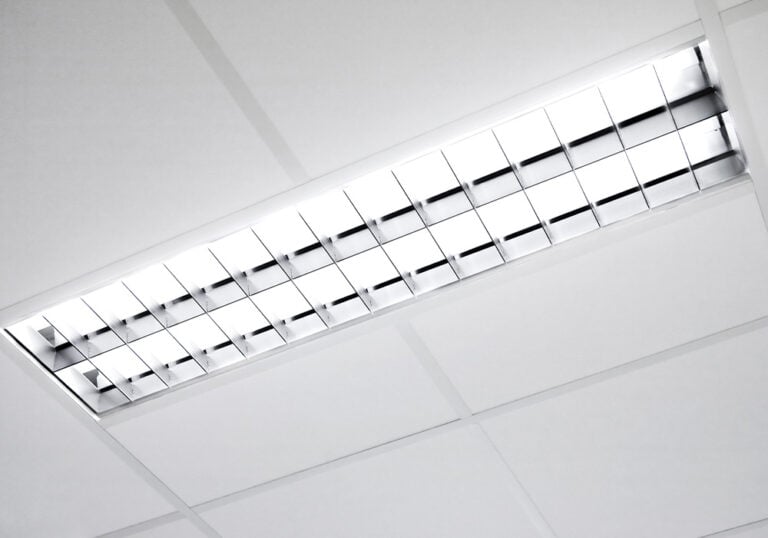What is the Cost to Install Downlights? A Concise Guide
When planning to enhance your home’s ambience and visual appeal, installing downlights is a popular and effective choice. Downlights are recessed lighting fixtures that provide focused and ambient lighting for various spaces. They can create a sleek and modern vibe, boosting your home’s aesthetics while also being energy-efficient.
Before installing downlights, it’s essential to consider the costs involved. The overall expenditure will depend on multiple factors, such as the type and number of downlights needed, whether you opt for professional installation or a DIY approach, and local market rates. It’s crucial to have a clear understanding of these aspects to make informed decisions regarding the installation process.
Key Takeaways
- The cost to install downlights depends on factors such as type, quantity, and installation method.
- Professional installation ensures safety and efficiency, but DIY options might help save on labour costs.
- Local market rates, additional costs, and the specific area in the house can impact the total expenditure.
Understanding Downlights
Downlights are a popular choice for modern, unobtrusive lighting in homes and commercial spaces. They are recessed lights, installed into the ceiling, providing even and focused illumination. Typically, downlights utilise LED bulbs, which are energy-efficient and long-lasting. Let’s delve into some important factors that impact the cost of downlight installation.
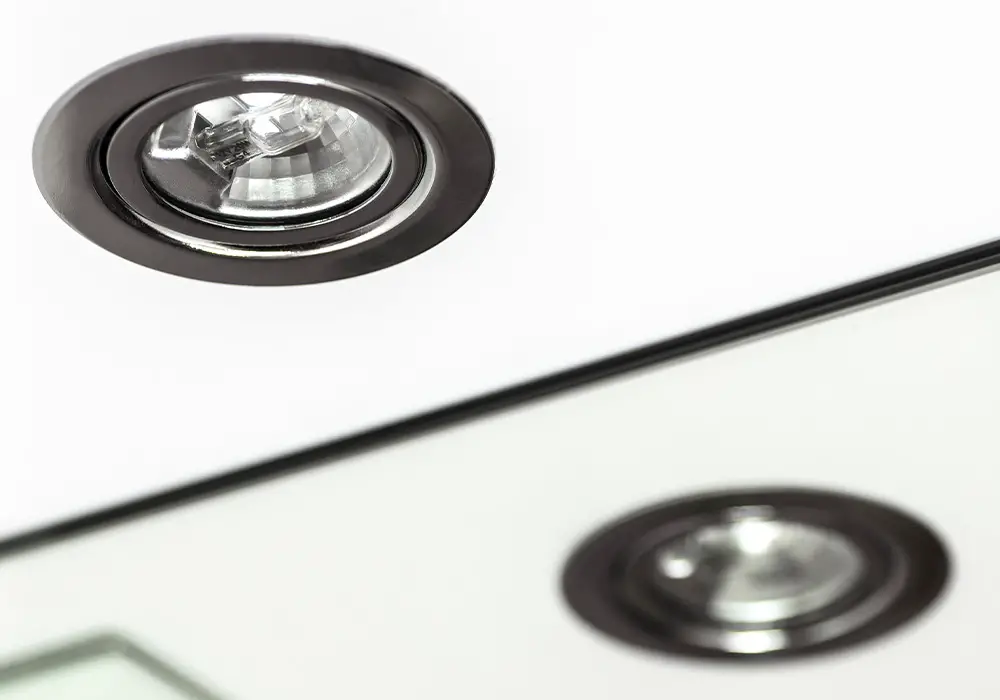
Materials: The prices of downlights vary significantly depending on the quality of materials used, the size of the light, and the technology employed. Entry-level downlights can be found for as little as £5, while more advanced options with features like adjustable colour temperatures and dimming capability can cost over £30 each.
Electrician’s fees: Your local electrician will charge on an hourly basis, which can typically range anywhere from £20 to £60 per hour. The complexity of your downlight installation may affect this cost, as more advanced systems may take longer to install.
Number of downlights: How many downlights you choose to have installed will naturally influence the overall cost. While considering your desired level of illumination, it’s essential to balance this with the necessary wiring and electrician’s labour costs.
Existing electrical setup: The current wiring and infrastructure in your space can directly affect the downlights installation cost. If your existing electrical setup supports the downlight installation, your electrician can get straight to work. However, if the wiring or the circuit needs to be modified or upgraded, expect to incur additional costs.
Building regulations: To ensure your electrical installation complies with safety standards, your electrician may need to notify the local building control department, which could result in an additional fee. Always consult a certified electrician to avoid any non-compliance or safety concerns.
Taking these factors into account, the total cost to install downlights varies depending on the type of lights, labour required, and the specific property configuration. By conducting a thorough assessment and consulting a professional, you can achieve the desired lighting effect while meeting safety standards and staying within your budget.
Factors Influencing Installation Cost
When considering the cost to install downlights, several factors can influence the overall expense. By understanding these factors, you can better plan and budget for your project.
The type of downlights you choose plays a significant role in the cost. Halogen downlights are generally less expensive but less energy-efficient, while LED downlights are more energy-efficient but have a higher upfront cost. Furthermore, the quality and brand of the lights also impact the price.
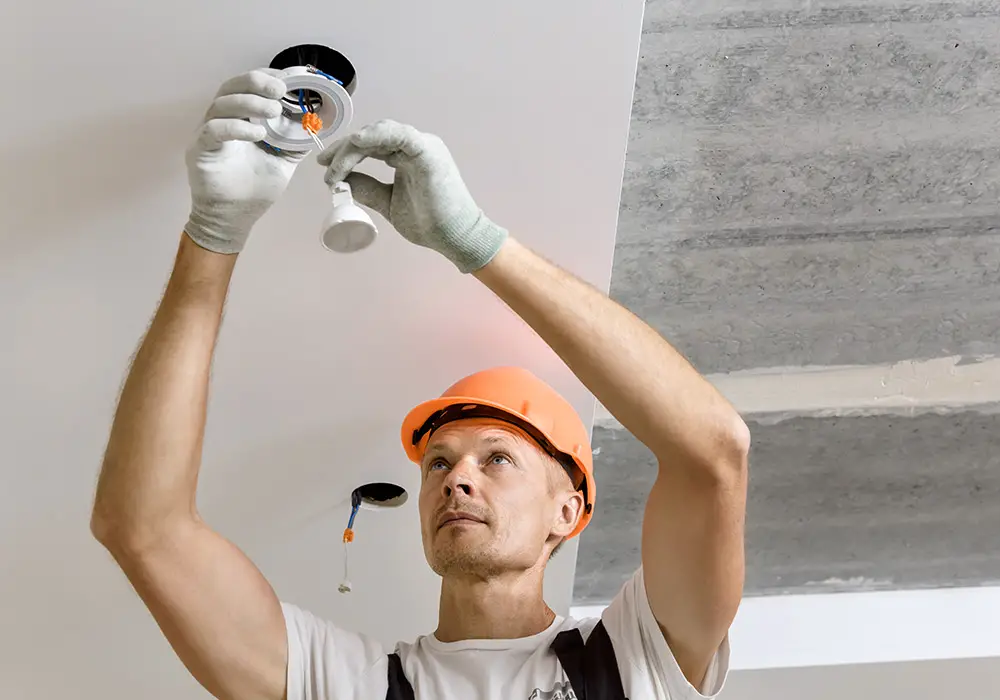
Labour costs vary depending on the contractor or electrician you hire. These professionals typically charge by the hour or provide a quote for the entire project. It’s a good idea to obtain multiple quotes to ensure you find a skilled professional at a reasonable price.
The complexity of the installation is another factor that affects the cost. If your home’s wiring requires significant alterations or if the ceiling is challenging to access, the installation may take longer and cost more. Adding dimmer switches or other features can also increase the overall cost.
Finally, the number of downlights you plan to install influences the price. Naturally, a larger installation with more downlights will be more expensive. However, the cost per light may decrease when installing multiple downlights, as bulk purchases and installations can result in discounts.
As you plan your downlight installation, it’s essential to account for these factors and ensure you achieve a balance between cost and quality. By doing so, you can create a well-lit and inviting space within your budget.
Type of Downlights
When choosing downlights for your project, it’s essential to consider the different types available. Here we will discuss the main types of downlights on the market and their applications.
Fixed Downlights are a popular choice for general lighting, usually mounted in a stationary position to project light directly downwards. These are ideal for providing well-distributed illumination across your room. The main advantage of fixed downlights is that they are straightforward to install and cost-effective.
Gimbal Downlights offer a higher degree of adjustability, allowing you to direct the beam angle more precisely. This makes them perfect for accent lighting or highlighting specific features in your space. The gimbal mechanism gives you added control over the direction of the light, which can be especially useful in spaces with architectural details or artwork.
Recessed Downlights are installed flush with the ceiling, creating a clean, minimalist appearance. They provide functional lighting with no visual clutter. Recessed downlights are suitable for spaces that require good lighting coverage without the need for overly decorative fixtures. Ensure your ceiling has adequate space for the recessed installation, as some designs may require additional clearance.
Surface Mounted Downlights do not require any recess in the ceiling, making them attractive for retrofitting. As they are installed directly onto the surface, these downlights are often slightly more prominent in appearance. However, they are perfect for use in homes where it might not be feasible to create recessed housings or when there’s a concrete or solid ceiling, where recessing would be more challenging.
Integrated LED Downlights come with a built-in LED light source, eliminating the need for separate light bulbs. These downlights offer energy-saving benefits and often boast a longer lifespan. They can be more expensive initially, but their longevity and lower energy consumption may balance out the cost over time. These types of downlights come in various styles, including fixed, gimbal, recessed, and surface-mounted options.
Choosing the right type of downlight depends on your specific requirements, such as the level of adjustability, desired aesthetic, and whether you prefer a more cost-effective or energy-efficient solution. By carefully considering your options, you will find the ideal downlight for your project.
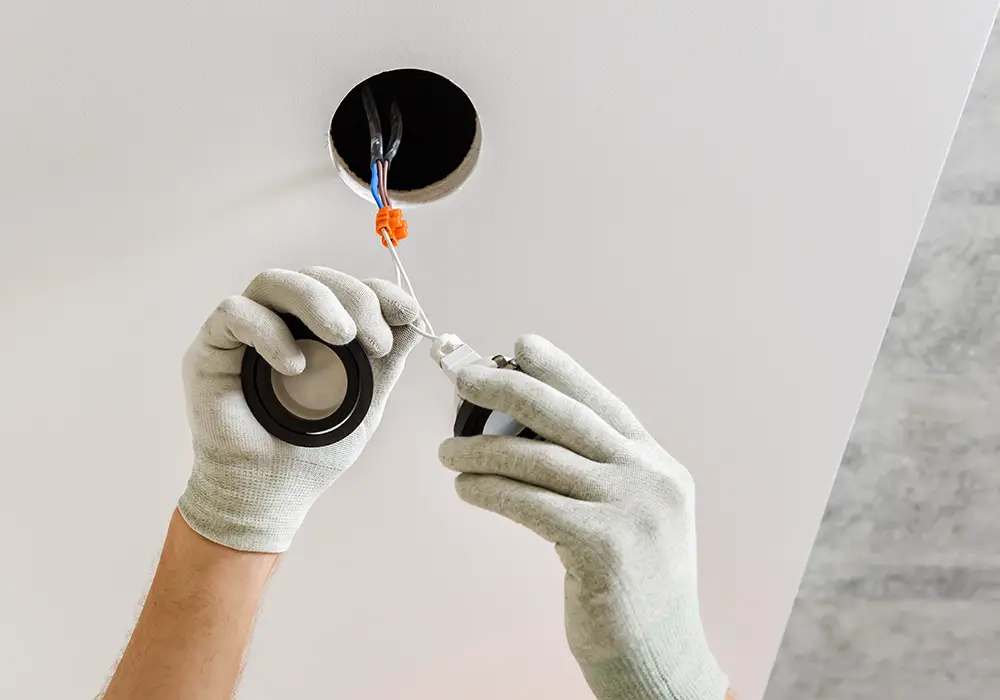
Number of Downlights Needed
When planning to install downlights in your home, it’s essential to determine the number of downlights needed to achieve the desired lighting effect. This will directly impact the overall cost of installation.
To calculate the number of downlights, first, measure the dimensions of your room (length and width), then consider the spacing and layout of the downlights. As a general rule, you should space downlights approximately 1.2 to 1.5 metres apart. This will provide a uniform, overlapping light distribution that eliminates dark spots and shadows.
For example, if your room measures 4 metres by 3 metres, follow these steps:
- Divide the room’s length by the optimal spacing (1.2 to 1.5 metres); in this case, 4 metres divided by 1.5 metres gives you approximately 2.6 downlights along the length.
- Divide the room’s width by the optimal spacing (1.2 to 1.5 metres); in this case, 3 metres divided by 1.5 metres gives you approximately 2 downlights along the width.
- Round up to the nearest whole number; you will need about 3 downlights along the length and 2 along the width.
- Multiply the two rounded numbers to find the total number of downlights needed; in this example, 3 x 2 = 6 downlights are required.
Keep in mind that these calculations are not set in stone and can vary depending on factors such as:
- Ceiling height
- Light output (lumens) of the downlights
- Individual preferences for brightness
Some rooms, such as kitchens and bathrooms, may require additional downlights for task-specific areas or to comply with safety regulations. Always consult a professional electrician or lighting designer for the best advice on the number of downlights needed in your specific space.
Professional Installation Vs DIY
Safety Considerations
When installing downlights, safety should be a top priority. Professional electricians are well-versed in safety protocols, such as properly isolating the electrical supply, ensuring correct grounding, and selecting suitable materials. They are also aware of the regulations governing electrical installations in your area. While you can still learn these safety measures, handling electrical installations without proper training may put you and your home at risk.
Expertise and Equipment
Professional electricians possess the necessary expertise and equipment to efficiently and correctly install downlights. They can help you determine the best layout and spacing for your lights, as well as recommend the most appropriate type of downlights for your needs. This can result in better lighting performance and energy efficiency.
When undertaking a DIY project, you may face challenges in selecting the right tools and materials – from hole saws to suitable cables. Additionally, amateurs may encounter difficulties in dealing with potential complications, such as unexpected wiring configurations or inaccessible ceiling spaces.
In conclusion, both professional installation and DIY approaches have their advantages and drawbacks. Weighing up the costs, safety considerations, and quality of the outcome will help you make an informed decision for your downlights installation project.
Cost of Downlight Units
When considering the cost of downlight units, it’s essential to keep in mind that various factors can influence the overall expense. These factors include the type of downlights, the number of units needed, and the quality of the products.
Types of Downlights: There are several types of downlights available in the market, each with its own price range. For example, LED downlights are energy-efficient and typically more expensive than traditional halogen or incandescent downlights. However, in the long run, LED downlights can save you money on energy bills and have a longer lifespan.
Number of Units: The total cost of downlight units will significantly depend on the number of units you plan to install. The more units you need, the higher the overall cost will be. Typically, bulk purchases can lead to discounts or reduced per-unit costs, so it’s worth considering this when planning your project.
Product Quality: As with most products, the quality of downlight units can significantly impact their price. High-quality downlight units may be more expensive initially, but they offer better durability, performance, and energy efficiency, ultimately saving you money in the long term. Conversely, low-quality units, while cheaper upfront, may lack longevity and efficiency, resulting in higher maintenance and energy costs over time.
To give you an idea of the cost of downlight units, here’s a simple breakdown of average prices:
- Halogen downlights: £5-£10 per unit
- LED downlights: £10-£30 per unit
- Smart downlights (compatible with smart home systems): £25-£60 per unit
It’s essential to weigh up the initial cost of downlight units against their long-term value, including energy efficiency and lifespan. By considering these factors, you’ll be better equipped to make informed decisions about the most suitable downlight units for your needs and budget.
Labour Costs
When planning to install downlights, it is important to consider the labour costs associated with the task. Generally, electricians charge an hourly rate, which can vary depending on the experience and location of the tradesperson.
In most cases, electricians in the UK charge between £25 and £60 per hour. However, it is possible that an electrician may charge a fixed price for the installation of downlights, especially if the location is straightforward and without any complexities. This pricing can range from £75 to £150 per downlight, inclusive of the call-out fee and any additional expenses such as travel costs.
When assessing the labour costs, consider that the installation time may vary depending on a few factors:
- The number of downlights you wish to install: Obviously, the more downlights you need, the longer it will take to complete the project, thus increasing the labour cost.
- The complexity of the wiring and ceiling: If your home has inaccessible spaces or requires additional work to run the wiring through the ceiling, the labour costs will increase due to the added time and effort involved.
- Your location: If you live in a densely populated city or region with a high cost of living, labour charges may be higher compared to rural or less populated areas.
Do remember to get several quotes from local electricians to compare the labour charges. It’s important to strike the right balance between quality work and a fair price. When discussing the project with electricians, make sure to ask about possible hidden costs as well as their experience with downlight installations to ensure a smooth and efficient process.
Additional Costs
Electrical Work
When installing downlights in your home, you may need to consider some additional costs related to electrical work. If your existing wiring is outdated or insufficient, an electrician may need to upgrade it to ensure the safe and efficient operation of your new downlights. Costs for electrical work can vary depending on the complexity of the job and the going rate in your area. Some factors that may affect the price include:
- The age and condition of your current wiring
- The number of downlights to be installed
- The distance between the electrical panel and the location of the downlights
Remember to get quotes from multiple electricians to ensure you’re getting a competitive price for the work required.
Ceiling Modifications
In some cases, you might need to make modifications to your ceiling before installing downlights. This can include:
- Cutting holes in the ceiling to accommodate the downlights
- Patching or repairing any damage caused by the installation process
- Adding insulation or making adjustments for the downlights to fit properly
The cost of these modifications can vary depending on the complexity of the installation, the type of ceiling material, and the size and number of downlights being installed. To ensure a smooth installation process and minimise any issues, consult with a professional who can assess your specific situation and provide an accurate estimate of the costs involved.
Considering these additional costs will help you avoid any surprises during the installation process. Be sure to factor these elements into your overall budget when planning to install downlights in your home.
Effects of Local Market Rates
When considering the cost to install downlights, it’s essential to factor in how local market rates will affect the overall price. The cost of labour and materials can vary greatly depending on your location. By understanding these differences, you can make an informed decision on whether to install downlights in your home.
In areas with high demand for electrical work, labour costs may be higher than in other regions. This is because electricians and tradespeople have more work available, allowing them to charge higher prices. On the other hand, regions with lower demand may offer more competitive rates due to increased competition among service providers.
Choosing materials can also impact the cost of downlights installation. The price of required supplies might differ based on regional availability and the quality of products you select. For example, you may choose between energy-efficient LED downlights, which can be more expensive initially but save you money in the long run; or traditional halogen downlights, which may have lower upfront costs but come with higher energy bills over time.
Additionally, local taxes, permits, and regulations can influence the overall cost of your downlights installation. Some areas may require additional inspections or fees for electrical work, which would add to the total price. Make sure to research any specific requirements in your region to avoid unexpected expenses.
To get an accurate estimate for the cost of installing downlights in your area, it’s best to obtain multiple quotes from local contractors. This will allow you to compare labour rates, material costs, and any additional fees to ensure you’re getting a fair price. Remember to factor in any potential disruption, like needing to repaint ceilings or patch holes left by old light fixtures, as they may add extra costs to your project.
Installation of downlights can be a significant investment, but understanding the effects of local market rates and making informed decisions about labour and materials will help you plan for the project more accurately.
Areas in the House and Their Impact
When considering the cost to install downlights, it is essential to think about the specific areas in your house. The installation process and costs may vary depending on the location of the downlights.
Kitchen: Downlights in the kitchen can create a practical work environment by evenly spreading light across countertops and stovetops. Since it is a high-moisture space, you may need to choose downlights with an appropriate IP rating. It might raise the cost slightly as compared to standard downlights.
Living room: This is the most common area for downlight installation. You can create a relaxing atmosphere or highlight specific artwork using downlights. Typically, you will need higher rated lights with more lumens to cover large spaces. Additionally, dimmable downlights may be preferred in living areas to create mood lighting.
Bathroom: Installing downlights in the bathroom requires extra precautions and adherence to safety regulations. Moisture and water exposure call for water-resistant downlights with a suitable IP rating. As a result, bathroom downlights tend to be more expensive and may require professional installation.
Bedroom: Downlights in the bedroom should provide an ambient and warm atmosphere. In this case, you might consider fewer downlights with lower lumens. Opting for dimmable lights enables you to adjust the brightness to suit your preference, enhancing the overall bedroom experience.
Outdoor areas: Downlights in external spaces, such as a patio or garden, often need to withstand weather elements like rain and dust. The cost to install these downlights might be higher due to the requirements for weatherproof and durable materials.
Remember, each area of your house has individual lighting design and safety needs. Therefore, it is essential to consider these factors when calculating the cost to install downlights. Though some areas may require a higher initial investment, the enhanced functionality and safety can be well worth it.

